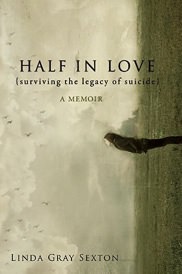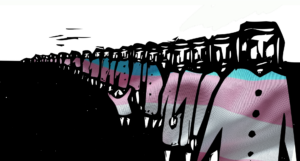Blood and Suicide
Linda Gray Sexton, a survivor of suicide attempts, explores her bitter-sweet connections to her mother, famed poet and suicide victim Anne Sexton, and delves into a force that takes tens of thousands of lives in the U.S. each year.A second memoir by Linda Gray Sexton, Anne Sexton's daughter, stares into the face of family and societal tragedy.
At first it was private. Then it was more than myself.
—Anne Sexton, More Than Myself
Private but more than yourself: that describes a good memoir. Linda Gray Sexton, who was blessed and cursed to be the daughter of the mercurial poet Anne Sexton, has written another one. “Half in Love: Surviving the Legacy of Suicide” picks up where Linda’s 1994 memoir, “Searching for Mercy Street: My Journey Back to My Mother, Anne Sexton,” left off. Both are intimate portrayals of this particular, enmeshed mother/daughter relationship, including the effects of Anne’s suicide at 45, when Linda was 21. While the new memoir isn’t as compellingly written as the earlier one, “Half in Love” is more important. It directly poses some weighty questions.
Such as these: How do we understand suicide, that most unnatural of deeds? Is it the ultimate selfish, cowardly act? Murder? A sin? Can it can be prevented through willpower or moral fortitude, or through the love of family and friends? Or is it the outcome of a medical condition, as morally neutral as, say, cancer?
Some readers might want to leave this review right now; suicide is hard to discuss. But avoiding the subject is part of the problem.. There are more suicides in this country than homicides, twice as many, though you would never know it from the scant attention paid. It’s more deadly than Parkinson’s or AIDS. According to the National Institute of Mental Health, 11.3 people in every 100,000 kill themselves, one every 17 seconds. For perspective, consider that the website you’re reading has more than 1 million unique visitors per month, and that you’ve probably spent about 17 seconds reading this far. [Also see PDFs on the CDC site.]
Linda grew up in chronic terror of her mother’s next suicide attempt (she counted more than 15). As an adult she becomes “one of the standard-bearers of anger” against this terrible act. Though she herself struggled with depression and felt the tug of suicide once, she resisted. When she had two sons, she vowed never to subject them to what she herself endured. She promised that she wouldn’t succumb to extreme depression as her mother had. She vowed never to try to kill herself.
Then she did all these things. Why?
“Half in Love” is a cry from the heart to recognize the suicidal drive for what it really is: mental illness, not failure. Ninety percent of suicide victims suffer from illnesses such as major depression or bipolar disorder, both with hereditary components. A recognized risk factor of suicide is a family history of it.
In “AIDS and Its Metaphors,” Susan Sontag described how AIDS, an illness “that elicits so much guilt and shame,” can’t be liberated from such judgments “just by abstaining from them. They have to be exposed, criticized, elaborated, used up.” That’s what “Half in Love” attempts to do for suicide.
Sexton was shocked that she ended up following in her mother’s dark footsteps. She had ended her first memoir (“Mercy Street”), published when she was 40, on an upbeat note. Though she still feared the legacy of disabling depression and suicide, she believed she could beat it. In the book she recounted her traumatic childhood and enmeshment with her mother in riveting detail, but by the end she seemed to have surmounted it. Writing the book, she says, had helped her “take control of the demons inside.”
But the demons, it appears, had merely gone into remission. The earlier memoir turned out to be only a “prelude,” as she writes in the introduction to “Half in Love” (the title is taken from John Keats’s poem “Ode to a Nightingale”: “… for many a time / I have been half in love with easeful Death”).
As she approached 45, the age her mother had been when she died, Linda starts to flounder. Her two sons are growing from babyhood into toddlers, and she discovers that as a mother she “didn’t have that most important thing of all: a good role model.” She longs to be a good mother, but the boys trigger her own memories and her sense of having failed to save her own. Soon she dreads seeing her children each morning, even though she loves them. She hates hurting them but seems unable not to. The more difficulties she has, the more she condemns herself. Even her therapist berates her for her “lack of nurturing instincts.”
Her husband, Jim, supported her through her mother’s death many years earlier, but now he starts traveling more for work — exactly as Linda’s own father had done (though oddly, the memoir doesn’t point this out, despite its constant psychological analyzing). Feeling isolated, Linda begins to wake before dawn in a sweat, her heart “pounding with extreme anxiety, unable to breathe.” She has been a successful novelist but can’t work. She and Jim argue. She drinks too much. She struggles with “quick swings from despondence to sudden agitation.” She keeps her “face averted so no one would know the shame of what was happening to me and how I was giving in. I was trying so hard — but, little by little, I was starting to fail.”
She is frightened for her children: Not only did her own mother kill herself, but so had her mother’s sister and a cousin, and also Jim’s grandmother and his mother’s cousin. Suicide had diseased the family tree. Is she the next carrier?
Her doctor diagnoses Bipolar II, connected at least partly to family history. But despite medications, despite her awareness, despite her spouse’s love, despite her love for her children — despite all the things that are supposed to protect us — over the next couple of years she spirals downward. Her new novel manuscript is rejected; the next one is, too. She begins to hoard her migraine medicine.
Why doesn’t she reach out for more help? She describes how the stigma of her mental illness and the family history of suicide keep her from confiding how she was really feeling: “I did not want to admit that I was depressed because I did not want to seem like Mother.”
She does approach her father and sister, but they “didn’t want to hear about depression or some crazy idea about a legacy of suicide. Just as my father and my grandparents on either side had urged my mother to ‘straight and up and fly right,’ both he and my sister now urged me to be strong, and ‘get with the program’” — to pull herself up by her own bootstraps.
The problem is that like many people born into situations of poverty — whether emotional, economic, social or political deprivation — she doesn’t have good bootstraps to pull.
As for professional help, she finds that most doctors don’t want to deal with suicidal patients because it’s so time-consuming. “A suicidal patient needs help more than any other, but because she needs it so much, she was very likely not going to receive it.”
Part 3 of the book opens with Linda waking in the hospital to find that she had slit her wrists in the bathtub, and her stomach is being pumped to combat an overdose. She can remember choosing the knife and pills, but “that morning I was compelled to wonder, however stupefied, how I came to be in the hospital. … The anxiety stopped my breath in my throat and I began to gasp for air….” Earlier in the book, in a flash-forward of this suicide attempt, she describes it like this: “The urgency pressed in upon me and flushed every family face, every family voice, from my mind.” In the poem “Wanting to Die,” Anne Sexton had used similar words, calling the suicidal impulse “the almost unnameable lust.” [In “Wanting to Die.” ]
Linda knows she had “crossed an invisible line. … Would I ever trust myself again? Would my family ever trust me again?” She sees that Jim “was a little afraid” of her now — and indeed she has destroyed her marriage. Her children visit her in the locked psychiatric ward just as she visited her own mother. “I had to admit it to myself—I had become a mother like my own.”
The next part of the memoir is the most difficult to read. She starts cutting herself regularly, trying to replace her emotional suffering with physical sensation. She plots and fails at another suicide attempt.
Eventually salvation comes in the person of a wise, empathetic psychiatrist. Sexton explores her mother’s legacy, especially the guilt she felt at not being able to keep her mother alive. In an echo of the reason she wrote “Mercy Street” — to help exorcise her demons — she follows the psychiatrist’s suggestion to write the rest of her story, which becomes “Half in Love,” as a way of helping “thousands of the mentally ill and their families, who often have no voice of their own.” One can only hope that this altruistic exorcism is more enduring for her than the earlier one.
She meets a new man. Her two sons, now teenagers, genuinely seem all right. She secures a contract for the new memoir. She reconnects with her father, but her sister, Joy, cannot forgive her suicide attempts; Joy sees them as manipulative, an indulgence. Sexton reports, “If I succumbed to a disease like breast cancer, one that was ‘life threatening,’ then she would be out to help me ‘in a heartbeat.’ Silently, I wondered why she didn’t perceive suicide as a life-threatening disease.”
Through this memoir we come to see that blame doesn’t belong in an arsenal for preventing suicide. Blaming the victim only worsens the situation; the victim already is mired in shame. When family members blame themselves because they didn’t save the deceased, they drink the poison too. As a child, Sexton describes how as a child she was completely and desperately focused on stabilizing her mother’s moods. “With my love, I would keep her safe.” But she couldn’t, of course, and her guilt at this supposed failure is a big part of perpetuating the legacy. Eventually she recognizes the error in having seen suicide as “an issue of love, when really it should have been seen as a barometer of pain.”
In making these good points, “Half in Love” unfortunately repeats itself quite a bit. The quotations that illustrate this review could have been swapped out for a number of others that said pretty much the same thing. The repetition makes the book feel more polemical than it needs to be.
Sexton also spends a lot of time summarizing the story in “Mercy Street,” which is necessary background but becomes a rehash. If you read “Mercy Street” first — it will be re-released by Counterpoint in April — the first hundred pages of “Half in Love” will feel especially repetitive. You might read the second memoir first, then “Mercy Street” for a deeper look into the relationship with her brilliant, tormented mother. For me, the first book was the more compelling story.
Both memoirs are weakest when Sexton strays into analysis, often expressed in stilted psychobabble. One example: “For love to have been big enough and strong enough, I would have had to have spent a lifetime learning to harness my suffering, to become adept at how to funnel difficulties of the soul into peaceful and productive channels so that its energy flowed out in ways that did not ravage.”
It’s clunky stuff compared with the lightning of her mother’s poetry:
… Meanwhile you pour tea with your handsome gentle hands. Then you deliberately take your forefinger and point it at my temple, saying, ‘You suicide bitch! I’d like to take a corkscrew and screw out all your brains and you’d never be back ever.’ And I close my eyes over the steaming tea and see God opening His teeth. ‘Oh.’ He says. I see the child in me writing, ‘Oh.’ Oh, my dear, not why.
— Anne Sexton, “Oh”
The poetry is unforgettable, but the poet, sadly, is gone. Linda Gray Sexton, fortunately, is still writing, still alive.
Cherilyn Parsons is a writer who lives in Berkeley, Calif. She has published feature stories and essays in the San Francisco Chronicle, Los Angeles Times, Online Journalism Review, New York Newsday, and literary anthologies. She currently works at the Center for Investigative Reporting and holds a master’s degree in professional writing from USC.
Your support matters…Independent journalism is under threat and overshadowed by heavily funded mainstream media.
You can help level the playing field. Become a member.
Your tax-deductible contribution keeps us digging beneath the headlines to give you thought-provoking, investigative reporting and analysis that unearths what's really happening- without compromise.
Give today to support our courageous, independent journalists.










You need to be a supporter to comment.
There are currently no responses to this article.
Be the first to respond.